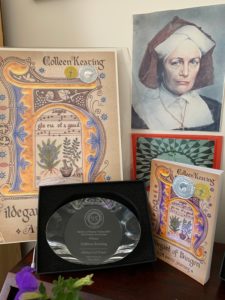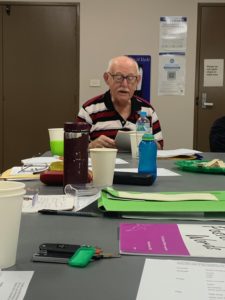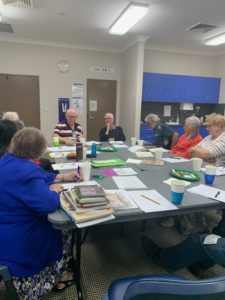
A Workshop on Writing and publishing Hildegard of Bingen: A poetic journey
for the Moolooboola FAW Writers Group President Renowned and award winning John Egan
MY BOOK
Thanks John. It is lovely to be here. John speaks enthusiastically of his Moolooboola group and I believe, I hope my story will motivate and inspire you all on your writing journeys.
Firstly this is my book, Hildegard of Bingen. It can be called a verse novel as the story is written in the poetic form . A tricky thing to do as you are aiming to be lyrical and poetic and at the same time driving a story line.
John asked me to tell you something about Hildegard. the woman who inspired me.
HILDEGARD
Most people know Hildegard through her music. In 2019 on ABC FM in a vote of the top 100 composers of the Western Musical oeuvre, Hildegard as Composer came 33rd ahead of many of the full known male names in music.
Hildegard was a fiery woman and a polymath. (someone of wide knowledge and learning – much done by absorption)
She was born in 1098 just on the turn of the century and she lived most of her 82 years in the 12th century dying in 1179 . It was a vibrant time of expansion and often called a Renaissance because they had come out of the so called Dark Ages. and in the next few centuries, powerful women were often burnt as witches/heretics at the the stake. She was a 12th mystic, prophet, musician , poet, writer, artist, herbalist and healer and a Benedictine nun where she lived the Benedictan way of daily prayer, work and study .
From the time she was 6 she had heard the voice of God speaking to her in visions. This concerned her parents. And as she was their tenth and last child they tithed her to God. They thought this life safer for her. They put her into the care of a wealthy young holy woman called Jutta and together they entered an anchorage (a room adjoining a chapel in a male monastery.) Jutta’s family were wealthy patrons of the monastery and so they were welcome there. Anchorites brought in revenue, food and produce as they had a window to the world to talk and counsel pilgrims.
Other women joined them and it expanded to a convent and when Jutta died Hildegard became the Magistra . Hildegard felt God was asking her to write down what she saw and heard she went to the Abbott in charge and said God called her to write her visions. He refused her permission.
As her wisdom developed she felt confined and began to stand up to the Abbott. She was kept silent and repressed until she couldn’t take the patriarchy any more. She got very sick and only because he thought her death would be on him he gave her permission to write and gave her a scribe . . a young monk called Volmar
She wrote ‘When I was 42 years and 7 months a burning light of tremendous brightness came down from Heaven and poured directly into my mind. It set my entire heart and being on fire, just as the sun that warms all around it by the strength of its rays.
Hildegard went on to write :
3 theological books,
the first morality play,
two medical books
77 liturgical songs
3 biographies and volumes of correspondence to Popes, Kings, Emperors and many others.
Every step of the way she had to overcome the repression of the Church, restriction of being a woman and patriarchy . When she decided to take her women to begin their own women’s abbey the men stopped them for ages as they were used to the women doing the gardening, making the medicines and doing the counselling and attracting the pilgrims which all bought in the money to the monastery. Even when they left they refused to release the women’s dowries which was another struggle.
Hildegard never gave up . . . biding her time and moving forward. She planned a way to move her now 20 sisters to a new place down on the Rhine River where she built her Abbey creating a place for housing 100 sisters, with an infirmary, hospice, herbarium and apotheke, a scriptorium, for scribing books remember there is no printing press as yet so every word , every note of every song had to be scribed. introduced her sister to running water verifying her healthy life style. SShe not only wrote but took on preaching tours up and down the Rhine
Building a second convent on the other side of the Rhine, her sisters caring for the people there and they were loved. Hildegard visited them weekly by row boat.
Her music, her writings on caring for earth and environment, health and well being and healing speak to us today very powerfully . She was one of the first to call the earth mother and she said we need to care for her as she nurtures and nourishes us.
MOTIVATION
My interest in Hildegard began in 1996 when I picked up an illustrated book of her life and work.
As I came to know her more it became a passionate pursuit.
On a sabbatical in 1998 I went in search of her. This meant physically a lone pilgrimage to her country, her land along the Rhine River in Germany. I walked in her foot steps sat in the ruins of the monastery where she lived for forty years and I found myself listening.
I wrote a poem of that journey which was shortlisted and commended in the Mary Gilmore Poetry Competition Women Speak for W omen.
That could’ve been it . Then after I retired, I saw a 3 week Benedictine retreat to be given in English in her country, Germany and live in her spirit. That is the daily three pillars of prayer, work and study. So this motivated a new urge in me to write more.
GETTING STARTED
I began taking a few poems of her early life to Norm’s writing group. and to the Women Writers Network at the NSW Writers Centre. At Norm’s group some enjoyed them but generally they got panned. John always wrote encouraging things. Told me not to listen to the whingers. Decima kept me going
However from that I learnt a lot . First person present tense even past tense was not working and could not be sustained. My usual type of poetry without punctuation looked weak for a verse novel. Allelua.
I learnt a lot and found moving into third person present worked. And using punctuation made it more accessible.
In the afternoon Women Writers Network, many looked forward to my next poem and that kept me on a roll. Some were actually outwardly excited when I had a new poem about her. They all came to love this woman.
So they energised me to write . . .all of us wanting the next piece. I felt I was bringing this 12th century woman into the present day. But even with that a heck of a lot of research was needed.
Sometimes I would think of the season and research the birds migrations nests winds and what the river was up to and the herbs and vegetations -vineyards etc. and research more and read and read put her music on and then the rest happened as I put pen to paper and so often the seasons mirrored her moods. That was an acclamation of one of the judges . How the landscape became a metaphor so often for her journey.
VISUALISATION
At this stage they were poems but then I did a one day workshop with Jan Cornell. Busting out your novel. I think it was called. She got us to map out what was inside us .
This was practical. It needed a title, it needed a cover . It needed direction, story line, chapters . We used butcher paper . . some of you might’ve tried this, even cut pictures out of magazines . to get characters . It was a fun day. I went home and put it all in the drawer. But as I looked back I had done something special that day. An intention was there. There was a new seed planted.
I had drawn a cover with the title
Hildegard of Bingen by Colleen Keating.
In a way it was using the secret.
What is ‘The Secret’? “The Secret” is simply the “law of attraction.” Essentially, the law of attraction states that whatever consumes your thoughts is what you will eventually get in life.
I visualised Hildegard in a book, my book .
And over the next few years she unfolded into a wild and woolly first draft.
read pg 57
THE SECOND DRAFT
All of you as writers are familiar with the draft.
It is advised, recommended to put aside the first draft for a few weeks. Then, 4 things need attention.
Characters.
Structure.
Dialogue
Thread of themes
PAUSE AND A NEW PERSPECTIVE
So Michael and I packed up and set off for Bingen .This time I had Michael with me an enthusiastic offsider. He loved Hildegard and as we walked in her footsteps his step was very light. It happened to be late Autumn which gave me a whole different perspective
from summer and spring of my last journeys. different but no less beautiful.
This time I knew German scholars of Hildegard to meet with and be guided by .
This pause was incredibly helpful process.
Firstly there was time away from the draft.
Then in Bingen each evening we talked about getting a bird’s eye view and refined the vision as we discovered the close up.
CHARACTERS
The character each needs to be given a lot of thought . Each needed an arc of development . Each need to be themselves not pawns I push to make the story I want. Volmar had to develop from a shy monk to be a maturing academic chosen for his ability in the scriptorium and he had to connect soulfully with the young girl Hildegard who was excited about everything. Sometimes the character of Hildegard reminded me of a 12th century Alice in Alice in Wonderland, curiouser and curiouser and often Scarlett O’’Hara in Gone with the Wind – fully alive and impatient to be about life with her arc in her maturity determined she will never be hungry again. And her close antagonist Abbot Kuno who like many acted out the patriarchy of the church.
Read young Hildegard First writings p87/88
STRUCTURE
When I was writing the first draft, as many of you know you are so immersed in detail and events that,as the writer , sometimes you don’t have the space to look at the big picture. That was fine .
For the journey is the journey. The road has been slowly making itself as I write. I can ask myself if I chose the less worn fork in the road, or whether I should have taken that particular scenic route, or just pressed on over the mountain.
It’s a bit like the Irish joke about asking directions: ‘Well, I wouldn’t start from here’.
It was at that point I felt it needed to begin at a later stage in her life. I chose a very painful pivot forming a Prologue and then flashing was able to flash back. Many have like that idea. I’ll read you the first poem. Read page 17.
After that I follow thru to the inevitable end so that after you have been on her journey I want you to sit silently in her honour at the end with hopefully a tear in your eye for the beauty of this life. One who stood up for women with
courage even as the odds were against her she never took a backward step.
DIALOGUE
You can see from my readings the interweaving of dialogue
In the second draft you will find scenes that can be put into dialogue. Often it pulls the reader into the experience, it quickens the pace of the scene, gives variety, portrays characters more into reality. My hint for success is to read it aloud over and over .
Always aloud. If possible record and play back all the time getting it a dramatic and as real as possible. Iphones make this easy.
p 198/199 on A visit from the Canon of Mainz.
THEMES
Now it was needed to find the themes that thread through the story and note if they have been sustained.
For Hildegard this included
- her music, singing
- her healing – plants well being
- environment, mother earth nature greening
- her writing, mandalas
- her belief in the ability of women
- Veriditas – greening power, vital green life in a plant moistness, verdancy vitality, growth, greenness, fecundity, lushness .
- Suppressed from writing, from setting up her own Abbey. They kept hold of her dowries. they used all the tactics to make the women fail.
- They silenced her music in the last year of her life because she refused to do what they wanted . She taught her women to find the song inside her heart and have the power inside themselves while she wrote a treatise on music . . . how it was the song of the angels and sang in Heaven and the only one that would silence it belongs to the devil and Hildegard played on the fear and superstition of the day and they gave her back her power and she died peacefully
WORKSHOP.
WRITING FOR 10 MINUTES ON A TIME YOU HAVEL FELT REPRESSED.
There were many well written and very interesting specimens writings shared.
John Egan thanked me for coming and Muchael for abeing there to support me and we received a wonderful bottle of Shiraz which Michael and I look forward to enjoying.




